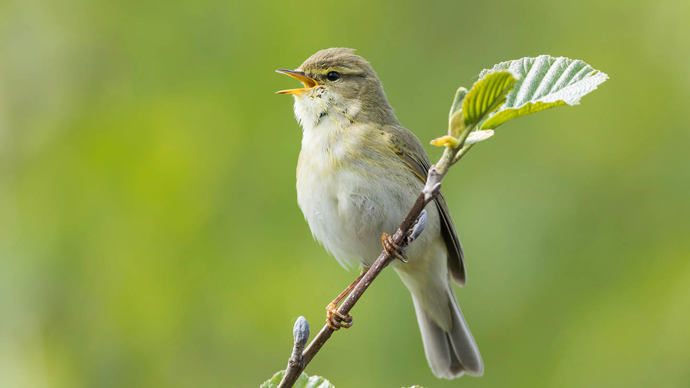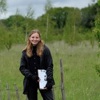
Credit: Chris Grady / Alamy Stock Photo
The easiest way to tell the two birds apart is by leg colour. Willow warblers have light brown legs. They also have a whiter belly.

Citizen science assistant
Chiffchaffs and willow warblers migrate to our shores every spring. Do you know how to tell the difference? Both species are in the same family - phylloscopus warblers - so look extremely similar. Many people struggle to tell them apart, but it's possible if you know what to look and listen for. Here are our top tips.
Chiffchaffs (Phylloscopus collybita) and willow warblers (Phylloscopus trochilus) both have greyish-green and white plumage with no striking features. They are small birds with slender legs and bill, but some small differences can help with ID.

Credit: Chris Grady / Alamy Stock Photo
The easiest way to tell the two birds apart is by leg colour. Willow warblers have light brown legs. They also have a whiter belly.

Credit: Amy Lewis / WTML
Chiffchaffs have black legs. They also constantly flick their tails, whereas willow warblers only do it occasionally.
Chiffchaffs and willow warblers have very different calls.
Chiffchaffs sound like they're saying their own name.
Listen to the distinctive song of a chiffchaff
Willow warblers sing a tinkling, descending phrase that ends in a slight flourish. This is repeated endlessly by birds arriving in the spring.
Listen to the distinctive song of a willow warbler

Credit: John Bridges / WTML
Willow warblers can be found in wooded or partly wooded habitats almost anywhere, although they often favour birch woodland areas and willow scrub.

Credit: Nature Photographers Ltd / Alamy Stock Photo
Chiffchaffs are associated with mature deciduous woodland with dense understory scrub during the breeding season.
While on passage, both birds can be found anywhere!
The Nature’s Calendar project tracks the effects of weather and climate change on wildlife across the UK – its records date all the way back to 1736! Chiffchaffs and willow warblers arriving in the UK are just two of 69 wildlife species recorded for the project.
From previous years' data, we would expect to start seeing chiffchaffs from early March and willow warblers from early April.
Join Nature’s Calendar to record your sightings - every record is crucial and valid. The data recorded helps us to better understand the effects of climate change and other patterns in the natural environment. By taking just a few minutes to share what you see, you'll be adding to hundreds of years' worth of important data. We couldn't do this work without you!


Help monitor the effects of climate change on wildlife near you. Your records contribute to a growing body of evidence on global warming.